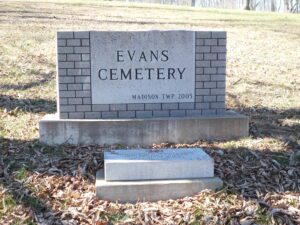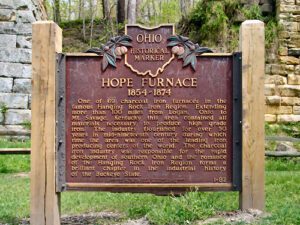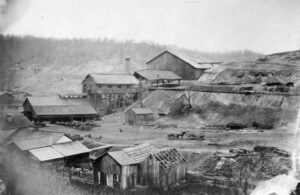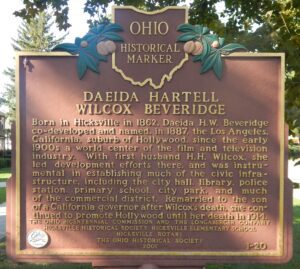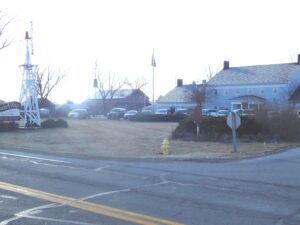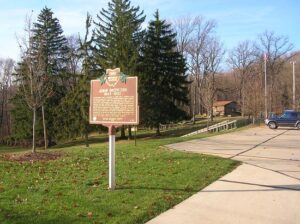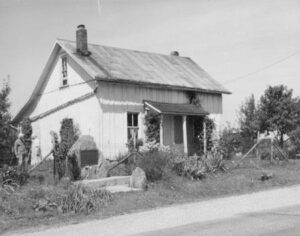, OH
One of 69 charcoal iron furnaces in the famous Hanging Rock Iron Region. Extending more than 100 miles, from Logan, Ohio, to Mt. Savage, Kentucky, this area contained all materials necessary to produce high grade iron. The industry flourished for over fifty years in the mid-nineteenth century, during which time the area was one of the leading iron producing centers of the world. The charcoal iron industry was an important factor in the development of southern Ohio, and the romance of the Hanging Rock Iron Region forms a brilliant chapter in the industrial history of the Buckeye State.
, OH
One of the 69 charcoal iron furnaces in the famous Hanging Rock Iron Region. Extending more than 100 miles from Logan, Ohio to Mt. Savage, Kentucky this area contained all materials necessary to produce high grade iron. The industry flourished for over 50 years in mid-nineteenth century during which time the area was one of the leading iron producing centers of the world. The charcoal iron industry was responsible for the rapid development of southern Ohio and the romance of the Hanging Rock Iron Region forms a brilliant chapter in the industrial history of the Buckeye State.
, OH
To furnish the needs of the early settlers, then to furnish ordnance for a nation at war, and finally to furnish merchant iron to the steel mills, 100 iron producing blast furnaces were built within these 1,800 square miles of the lower coal measures to become known as the Hanging Rock Region. Lawrence County, centrally located within the Region, had 23 blast furnaces constructed between 1826 and 1909.
, OH
Born in Hicksville in 1862, Daeida H.W. Beveridge co-developed and named, in 1887, the Los Angeles, California, suburb of Hollywood, since the early 1900s a world center of the film and television industry. With first husband H.H. Wilcox, she led development efforts there, and was instrumental in establishing much of the civic infrastructure, including the city hall, library, police station, primary school, city park, and much of the commercial district. Remarried to the son of a California governor after Wilcox’s death, she continued to promote Hollywood until her death in 1914.
, OH
A pioneer furniture manufacturer and philanthropist, Erie J. Sauder (1904-1997) was born and reared on a farm in Archbold. With the help of his wife Leona, he began woodworking in their town barn in 1934. Crafting tables and church pews, the Sauder Woodworking Company grew quickly. Sauder’s 1951 invention of an easily shipped table kit heralded the modern ready-to-assemble furniture industry and firmly established the company as one of Fulton County’s primary employers. In 1976 Sauder founded the Sauder Village to interpret nineteenth century rural lifestyles in the Black Swamp region.
, OH
As a member of the Connecticut Land Company, Judge Samuel Hinckley of North Hampton, Massachusetts purchased township 4N Range 13W of the Western Reserve in 1795 for a sum equivalent to 23 cents an acre. The township remained unsettled until Abraham Freeze was commissioned by Judge Hinckley in 1819 to survey the township into 100 plots of 160 acres each. In return for having the township, founded in 1825, named “Hinckley,” the judge gave land for two burying grounds and one-half acre for a public square. In 1919, upon the 101st anniversary of the “Great Hinckley Hunt,” where men from surrounding counties gathered on Christmas Eve to rid the township of wild animals, Judge Amos Webber spoke for the deceased Judge Hinckley: “When I last saw this country, it was a howling wilderness – by industry and frugality you and your ancestors have made these ever lasting hills and pleasant valleys blossom as the rose.”
, OH
One of America’s best-known sport shooters and entertainers of the late 1800s, Annie Oakley was born Phoebe Ann Mosey (or Mozee) north of Versailles in Darke County in 1860. She achieved local fame for her shooting ability as a hunter while still in her teens. By 1885 Oakley was a star performer in Buffalo Bill’s Wild West. With husband and manager Frank Butler, she refined a shooting act and image that appealed to late 19th century notions of a romanticized but vanishing West. Throughout her 30-year performing career, Oakley provided honest entertainment in a deception-prone industry while demonstrating widening opportunities for women. She retained her Ohio ties throughout her life and is interred at Brock Cemetery, eleven miles north of Greenville.
, OH
Johann Mischler (changed to John Mishler), 1852-1930, and his wife Rosina Beyeler Mischler, 1852-1927, were born in Switzerland and came to the United States in 1882. They moved to Smithville in 1887 where John, a weaver by trade, built a mill to produce rugs and carpets on a hand operated timber framed barn beam loom. Three belt driven looms were added in the early 1900s powered by steam and later diesel. About 1915, the weaving mill became the first business in Smithville to be operated by electricity. The mill wove cloth for fruit presses and dishcloths and towels and was the only producer of cheesecloth in the United States for the Swiss cheese industry. It produced 40,000 pounds of cloth per year. John’s son Daniel took over the mill in 1930 and moved it a block away to its present location. Charles Norris purchased the mill in 1983. Ten years later, it was purchased and restored by the Smithville Community Historical Society.


